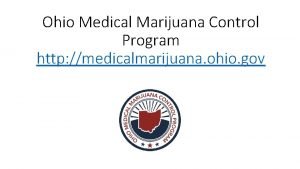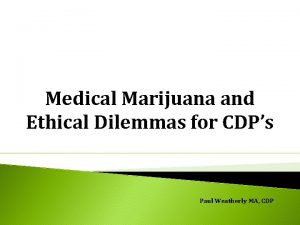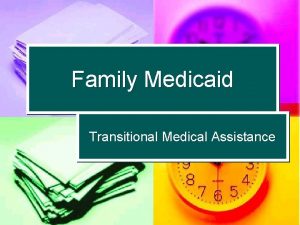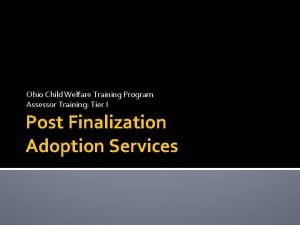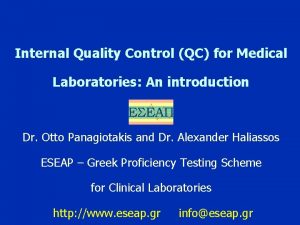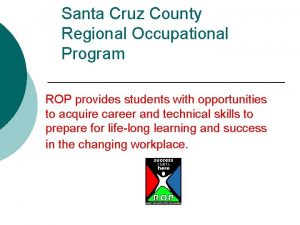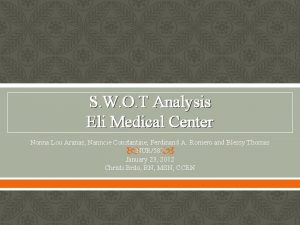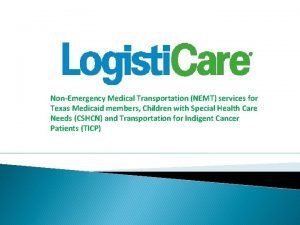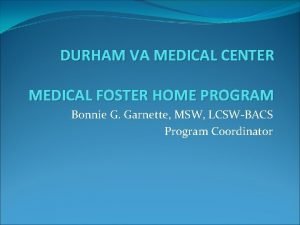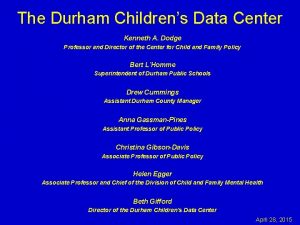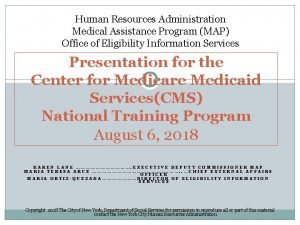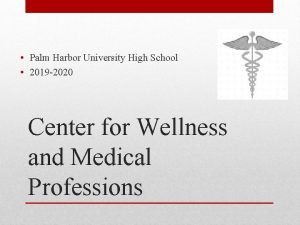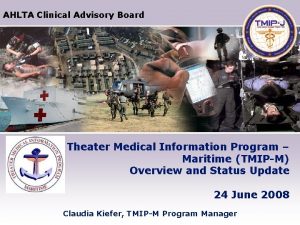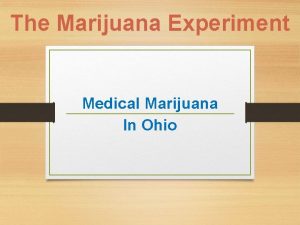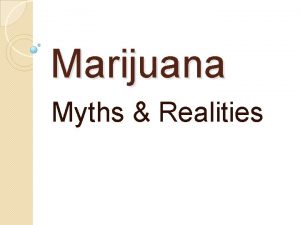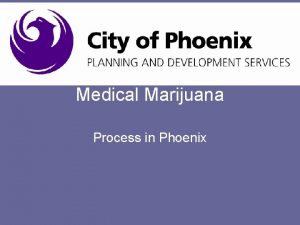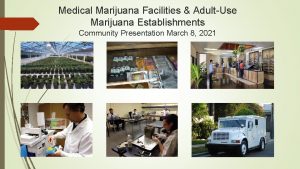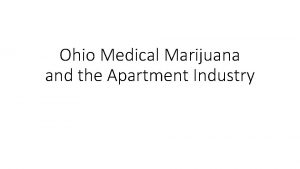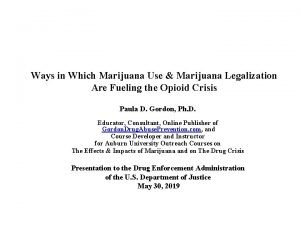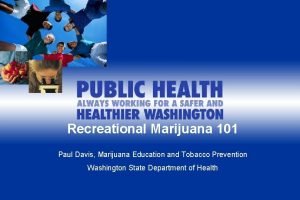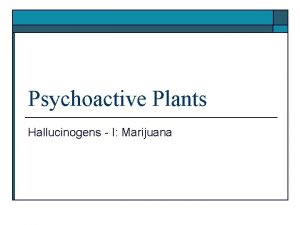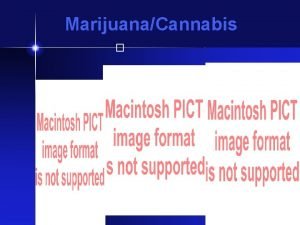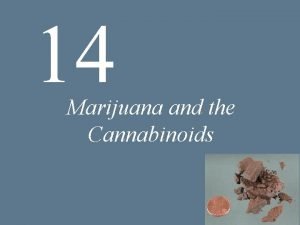Ohio Medical Marijuana Control Program http medicalmarijuana ohio






























- Slides: 30

Ohio Medical Marijuana Control Program http: //medicalmarijuana. ohio. gov

Guiding Principles Medical Marijuana Control Program is: 1. Patient-centered and safe. 2. Responsive, data-driven, and transparent. 3. Flexible, scalable, and sustainable. 4. Characterized by consistency, integrity, and collaboration across one program. 2

Timeline • September 8, 2016 – House Bill 523 Effective • November 1, 2016 – First Medical Marijuana Advisory Committee meeting • May 6, 2017 – Cultivator rules adopted • September 8, 2017 – All other rules adopted • September 8, 2018 – Ohio Medical Marijuana Control Program operational • October 8, 2021 – Medical Marijuana Advisory Committee sunsets

Medical Marijuana Process Flow Chart Cultivators Processors Testing Lab Dispensaries Patients Physicians

Who is Responsible? Department of Commerce • Cultivators • Processors • Testing laboratories State Board of Pharmacy • Dispensaries • Patients/Caregivers • New forms and methods of medical marijuana Medical Board • Certified physicians • New qualifying conditions

Ohio Department of Commerce

Department of Commerce Responsibilities • Issue licenses to medical marijuana cultivators, processors and testing laboratories in the State of Ohio, which includes the following: • Number of licenses issued for each business type; • Production control mechanisms; and • Eligibility criteria for licensure. • Develop rules necessary for the administration of the program, such as: • • • Facility security; Product quality control and assurance; Packaging and labeling standards; Product consistency and availability; and Testing laboratory standards and uniformity of analysis. Establish enforcement and compliance measures with licensure requirements.

Cultivators • When drafting the regulations, the MMCP balanced the cost of compliance with the benefit of the regulation. • Based on conversations with regulators in others states with established medical marijuana programs and industry stakeholders, Ohio pursued different mechanism that are unique in the industry. • The MMCP created two levels of cultivator licenses with different production capacities. • Level I – up to 12 licenses prior to September 8, 2018. • Level II – up to 12 licenses prior to September 8, 2018. • Existing licensees have the ability to expand the marijuana cultivation area if certain triggers are met. • Level I licensees can have 25, 000 sq. ft. of marijuana cultivation area. Expandable to 50, 000 sq. ft. and 75, 000 sq. ft. , dependent on demand. • Level II licensees can have 3, 000 sq. ft. of marijuana cultivation area. Expandable to 6, 000 sq. ft. and 9, 000 sq. ft. , dependent on demand. • The MMCP identified the need for a plant-only processor license to allow for direct shipment of plant material from a cultivator to a dispensary. 8

Processors • The O. R. C. 3796 establishes the approved forms and methods of administration for medical marijuana, and the processor rules accommodate the different methods used to manufacture these forms. • Flexibility is important as new processes and methods surface as the market matures, as well as new forms are approved by the board. • Set the annual license fee at an amount that reflects the plant-only processor license and the limited forms available at the Program’s inception. • A ceiling was set at 40 processor licenses to allow for vertical integration and greater product variety for patients. 9

Testing Laboratories • Provides a mechanism to issue public university licenses and private laboratory licenses in accordance with H. B. 523. • Offers testing flexibility at different points during the manufacturing process to eliminate redundancies, control costs, and ensure patient safety. • Creates a universal standard for licensed labs that can accommodate future advancements in analytical techniques without departing from that standard. 10

HB 523: Department of Commerce Cultivator Application Process • Department is accepting applications in two phases: • Level II Cultivator Applications: June 5, 2017 – June 16, 2017 • Level I Cultivator Applications: June 19, 2017 – June 30, 2017 • Webinar has been posted and Q & A is in process to offer clarification. • The fee for Level I applicants is $20, 000 and the fee for Level II applicants is $2, 000.

HB 523: Department of Commerce “Seed-to-Sale” Electronic Database • Establish and maintain an electronic database to monitor medical marijuana through cultivation, processing, testing and dispensing • May contract with a separate entity to establish and maintain all or any part of the electronic database • Database shall update medical marijuana information instantaneously • Cultivator, processor, retail dispensary and testing laboratory all required to submit any information deemed necessary for maintaining the database

State Board of Pharmacy

Pharmacy’s Role in Rule Development Responsible for rules relating to: • Registration of patients/caregivers • Retail dispensaries • Form and method of medical marijuana, including a 90 -day supply Authorized to: • Enforce rules related to patients/caregivers and dispensaries • Use Ohio Automated Rx Reporting System for the collection of information related to dispensing medical marijuana to registered patients • Disseminate registered patient information to retail dispensaries

• The Board may issue up to 60 dispensary licenses through a competitive selection process • Dispensaries will be required to report to the Ohio Automated Rx Reporting System in real-time Dispensaries • Employees will be required to be licensed with the Board and to wear Board-issued ID cards while on dispensary premises • Dispensaries will have to develop a policy for the education of patients and caregivers • Dispensaries will be required to pay a $5, 000 application fee and $70, 000 biennial licensing fee

• All patients and caregivers must register with the Board to receive a state-issued medical marijuana patient identification card Patients and Caregivers o Registration will be electronic and can be submitted by a patients recommending physician or physician’s delegate o Annual registration fee is $50 for patients and $25 for caregivers • Patients under 18 must have a parent or legal representative as a caregiver • A person must be 21 to serve as a caregiver and patient can have up to 2 caregivers; each caregiver can have up to 2 patients

House Bill 523 -Approved Forms Oils Tinctures Edibles Plant material Patches

House Bill 523 Prohibitions on Form and Method of Administration Forms and methods considered attractive to children Forms that require smoking or combustion

• Responsible for most of the psychoactive effects of cannabis • Best available clinical data is for less than 23% THC Content o Data focuses on efficacy based on THC content o Does not take into account the “Ensemble Effect” (also known as the Entourage Effect) o Limited studies demonstrate this effect at this time • Encouraging stakeholders to provide us with additional studies

90 -Day Supply of Plant Material Tier 1 THC Content Maximum 90 THC Medical -Day Supply Efficacy 0 – 23% 8 oz. 10 oz. + Adverse Events + (terminal exception) Tier 2 23. 1 – 35% 5. 3 oz. 6. 6 oz. (terminal exception) +

90 -Day supply of medical marijuana based on THC content Form Tier I plant material (up to 23% THC) Patches for transdermal administration 90 -Day Supply 8 ounces of plant material; 10 ounces for terminal exception 5. 3 ounces of plant material; 6. 6 ounces for terminal exception 53. 1 grams of THC; 65. 7 grams for terminal exception 26. 6 grams of THC; 33. 3 grams for terminal exception Edibles, oils, and tinctures for oral administration 9. 9 grams of THC; 11. 7 grams for terminal exception Tier II plant material (over 23% THC) Oils for vaporizing

Doses in a 90 -day Supply for Oral Administration 990 495 330 198 10 20 Concentration (mg) 30 50

Medical Board

Recommending v. Prescribing • The Federal government prohibits doctors from being able to prescribe marijuana • Patients must have a recommendation from a certified physician • Interested physicians must apply for a certificate to recommend (CTR) from the State Medical Board • The process to develop the CTR will be established in Medical Board rules • Must be adopted by September 2017.

Qualifying Conditions • • • AIDS Amyotrophic Lateral Sclerosis Alzheimer’s Disease Cancer Chronic Traumatic Encephalopathy Crohn’s Disease Epilepsy / Seizure Disorder Fibromyalgia Glaucoma Hepatitis C • • • Inflammatory Bowel Disease Multiple Sclerosis Pain: Chronic/Severe or Intractable Parkinson’s Disease Positive Status for HIV Post-traumatic Stress Disorder Sickle Cell Anemia Spinal Cord Disease or Injury Tourette’s Syndrome Traumatic Brain Injury Ulcerative Colitis

Physician interest 15% How likely would you be to recommend medical marijuana to a patient with a qualifying condition? (percent of responses) 3% Extremely 82% Respondents MD DO Somewhat Neutral Other 17. 37 More than 3, 000 licensees responded. There approximately 46, 000 physicians (MDs and DOs) currently licensed with the State Medical Board of Ohio. 15. 55 26. 05 12. 28 11. 21 Down 7% from the original survey in September. The difference shows up as in increase in the N/A category of respondents who indicated they do not manage patients with qualifying conditions. Likely Unlikely Neutral 17. 54 N/A 26

House Bill 523 The Medical Board’s rules establish following: • Procedures when applying for a certificate to recommend medical marijuana • Conditions that must be met to be eligible for a certificate to recommend • Schedule and procedures for renewing a certificate to recommend • Reasons for which a certificate to recommend may be suspended or revoked • Standards under which a suspension of a certificate to recommend may be lifted • Minimal standards of care when recommending treatment with medical marijuana 27

Employer Provisions – 3796. 28 House Bill 523 does not: • Require an employer to permit or accommodate an employee's use, possession, or distribution of medical marijuana; • Prohibit an employer from refusing to hire, discharging, disciplining, or otherwise taking an adverse employment action because of that person's use, possession, or distribution of medical marijuana; • Prohibit an employer from establishing and enforcing a drug testing policy, drugfree workplace policy, or zero-tolerance drug policy; • Interfere with any federal restrictions on employment; • Permit a person to commence a cause of action against an employer for refusing to hire, discharging, disciplining, discriminating, retaliating, or otherwise taking an adverse employment action against a person with respect to hire, tenure, terms, conditions, or privileges of employment related to medical marijuana; • Affect the authority of the administrator of workers' compensation to grant rebates or discounts on premium rates to employers that participate in a drugfree workplace program.

Municipalities and Townships – 3796. 29 • The legislative authority of a municipal corporation may adopt an ordinance, or a board of township trustees may adopt a resolution, to prohibit, or limit the number of, cultivators, processors, or retail dispensaries licensed under this chapter within the municipal corporation or within the unincorporated territory of the township, respectively. • Municipalities or townships cannot adopt an ordinance or resolution limiting research related to marijuana conducted at a state university, academic medical center, or private research and development organization as part of a research protocol approved by an institutional review board or equivalent entity.

Medical. Marijuana. Ohio. Gov Designed to keep Ohioans informed about the development of Ohio’s Medical Marijuana Control Program • Important Program milestones • Announcement of opportunities for public input 30
 Ohio mmj day chart
Ohio mmj day chart Should marijuana be a medical option
Should marijuana be a medical option Medical marijuana ethics
Medical marijuana ethics Became marijuana state
Became marijuana state Lungs marijuana
Lungs marijuana Halucinogens
Halucinogens Brown weeds
Brown weeds Transitional medical assistance ohio
Transitional medical assistance ohio Http //mbs.meb.gov.tr/ http //www.alantercihleri.com
Http //mbs.meb.gov.tr/ http //www.alantercihleri.com Http //pelatihan tik.ung.ac.id
Http //pelatihan tik.ung.ac.id Adoption assessor training ohio
Adoption assessor training ohio Ptal california medical board
Ptal california medical board Gbmc medical records
Gbmc medical records Difference between medical report and medical certificate
Difference between medical report and medical certificate Torrance memorial map
Torrance memorial map Cartersville medical center medical records
Cartersville medical center medical records Internal quality control in laboratory
Internal quality control in laboratory Medical assistant rop
Medical assistant rop Makati medical center charity program
Makati medical center charity program Medicaid transportation texas logisticare
Medicaid transportation texas logisticare What is a medical foster home
What is a medical foster home Berkshire medical center program
Berkshire medical center program Medical foster home program
Medical foster home program Darb medicaid
Darb medicaid Palm harbor university high school medical program
Palm harbor university high school medical program Tmip j
Tmip j Primary control vs secondary control
Primary control vs secondary control Distinguish between process control and product control
Distinguish between process control and product control Fluids mechanics
Fluids mechanics Stock control e flow control
Stock control e flow control Control volume vs control surface
Control volume vs control surface
